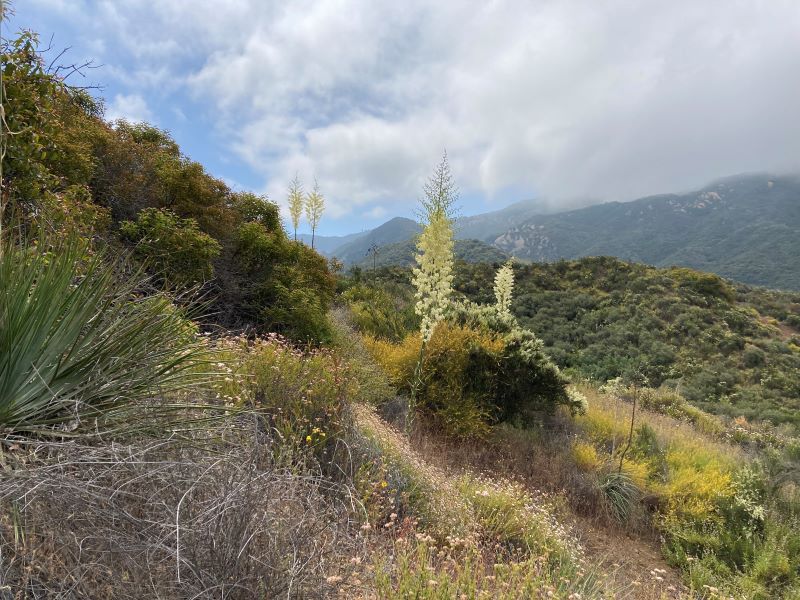
We saw the white fire of the yucca,
Lighting the mountains—
And still along the trail
Spring’s flowers lingered for summer.
—Madeleine Ruthven, “Yerba Buena,” Londelius Came to the Mountains, 1934
In late spring and early summer, thousands of tall panicles of white blossoms appear throughout the Santa Monica Mountains. They stand, tall and solitary, like candles or torches, like angelic beings or ghosts—larger than life, almost luminous in bloom, skeletal and gray when the flowers have gone to seed. Sentinels that can endure for years, weathering to an austere silvery gray, the bleached bones of giants.
Everyone who lives in this area is familiar with the sight of these sentinels, so much so that sometimes we simply accept them as part of the landscape and forget to notice how extraordinary they are. Chaparral yucca is a California endemic. It is found only in the area between Baja California and Monterey, and is more abundant in the coastal ranges, although smaller populations can also be found in the western Sierras, as far north as Kings Canyon, to an elevation of around 8,500 feet.
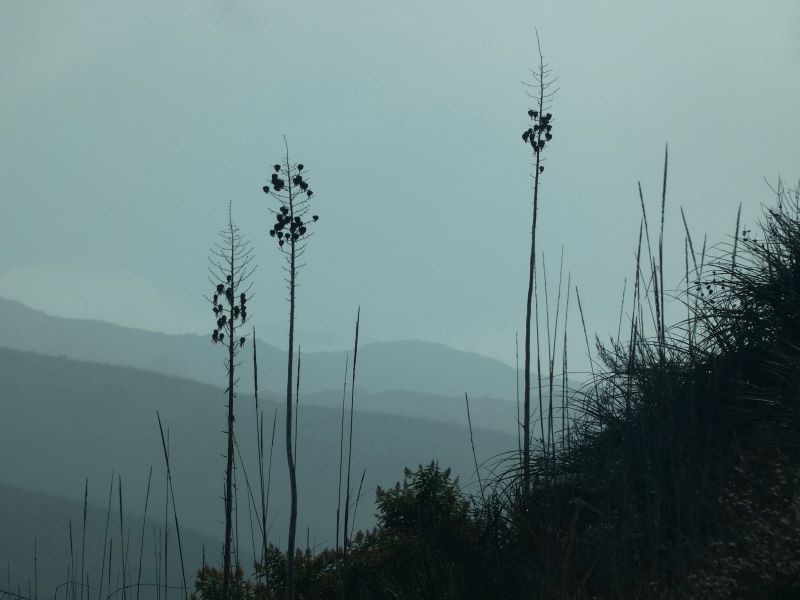
The scientific name for this plant is Hesperoyucca whipplei, named for US Brigadier General Amiel Weeks Whipple, the American topographical engineer who led a survey in search of a transcontinental railroad route along the 55th parallel from Arkansas to California, before being shot and killed by a sharpshooter at the battle of Chancellorsville in 1863, during the American Civil War.
This species used to be just Yucca whipplei. The recent—and still controversial—change of taxonomy was based on DNA analysis published in 2000 that shows that this species is genetically distinct from the yucca family and more closely allied to the agaves. It can take a long time for a change in taxa to be fully accepted. Arguments over the reclassification of species like this one can rage for years, and while H. whipplei is no longer a yucca, it remains a member of the genus Asparagaceae, together with agaves and true yuccas.
H. whipplei is one of just two native species of this genus in the Santa Monica Mountains—the other is the much smaller and more ephemeral Chlorogalum pomeridianum, the wavy-leaf soap plant. H. whipplei has a lot of common names. Chaparral yucca, or just plain yucca, is the most widely accepted, and unlikely to change, despite the recent reassessment of the species’ antecedents. This plant’s stiff, needle-sharp, pointed leaves give it the no longer politically correct name “Spanish bayonet.” Its beautiful spike of blossoms is the source of the name “Candles of the Lord,” “Our Lord’s Candles,” or “Lord’s Candles.”
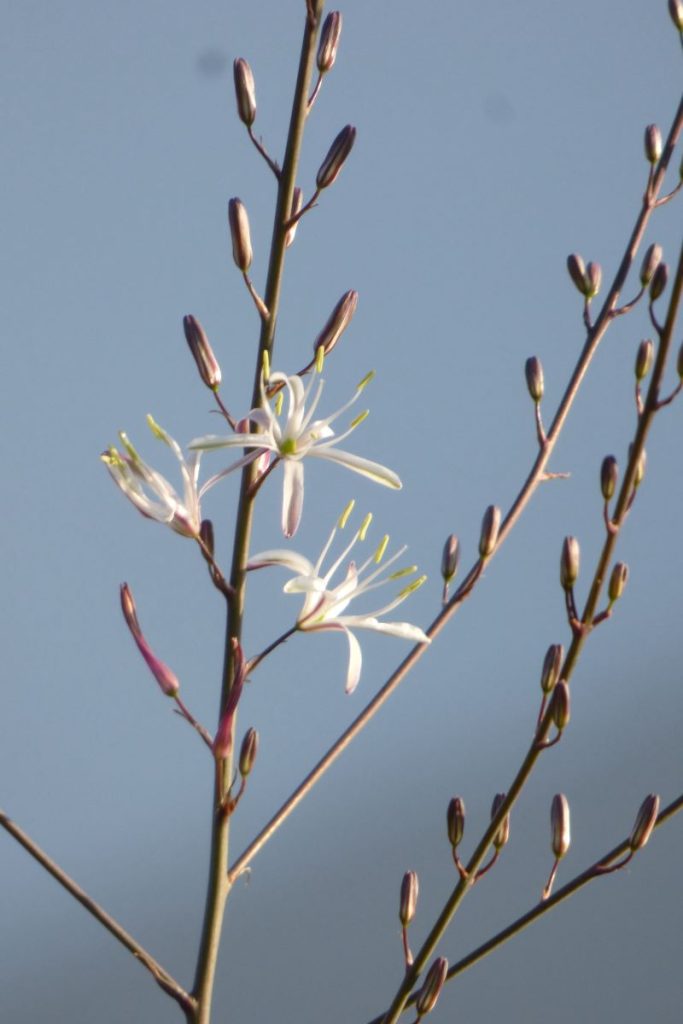
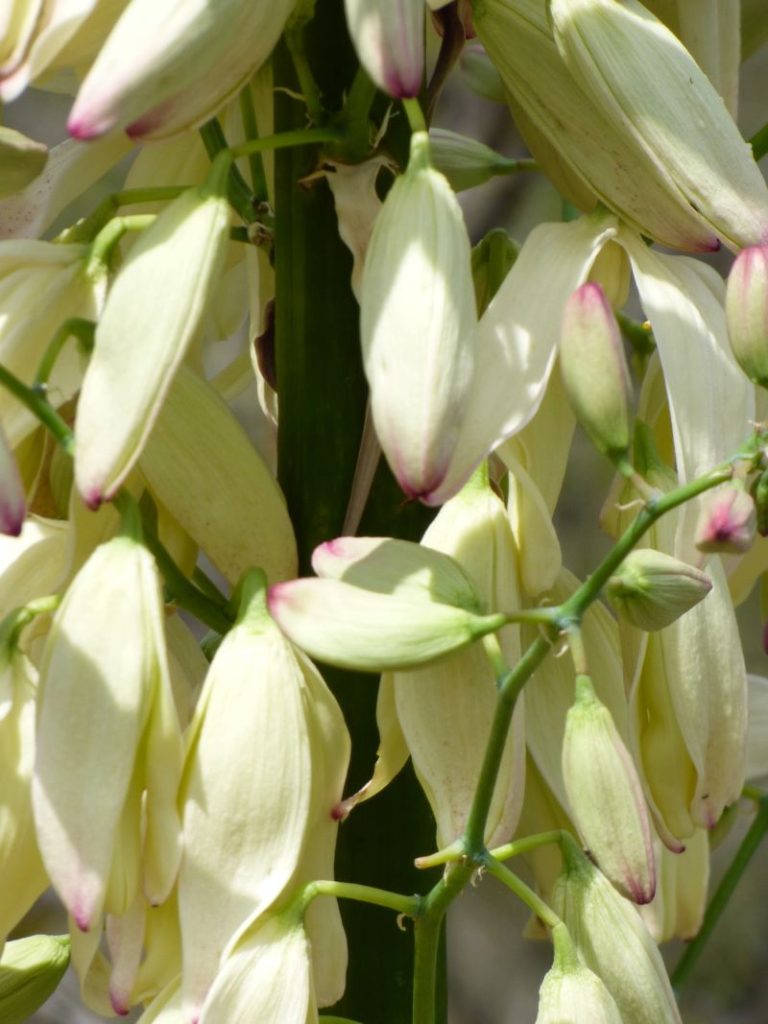
For thousands of years before the arrival of European colonists, the Chumash and other Indigenous people of California valued this plant and made use of almost every part of it. The fibers in the leaves are still used to make a supple, strong and durable cordage. The flowers can be eaten fresh in moderation, or cooked in several changes of water to remove bitter saponins. The seeds are eaten fresh or dried. The entire inflorescence can be baked or roasted like the giant asparagus stalk it resembles (and is related to). Once the flowers have faded and the fruits have opened and released their seeds, the dry stalk makes a handy walking stick: light, smooth, strong, and straight.
Ancient yucca roasting ovens are found throughout the Santa Monica Mountains, including sites located in and around Topanga. Middens—ancient compost piles—also reveal the extensive use of this plant.
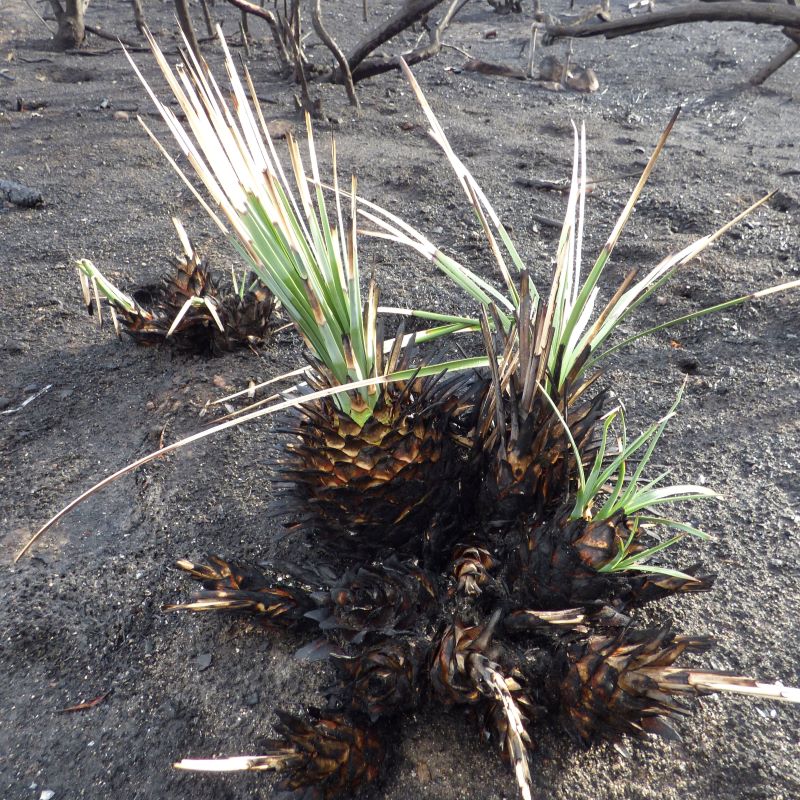
Chaparral yucca takes a long time to flower—up to eight years. This is a monocarpic plant, meaning it usually dies after blooming, but it also produces clones of itself—offshoots that grow from the base of the parent plant.
H. whipplei has become a popular landscaping plant. While it blooms infrequently, it is drought tolerant and its rosette of silvery-green leaves is attractive, and can grow to be as much as four feet high and five feet across. It’s important to remember that the leaves of this plant are extremely sharp. They can deliver a painful poke, and the saponins that the plant produces can cause an allergic reaction that includes swelling and is sometimes followed by infection. It’s a good idea to avoid planting this species in places where children or pets play, or near a walkway, and to use caution when hiking or gardening. The saponin helps protect the plant from predators, and adds a toxic edge to the sword-like barrier that helps protect the plant’s tender flower stalk and succulent blossoms.
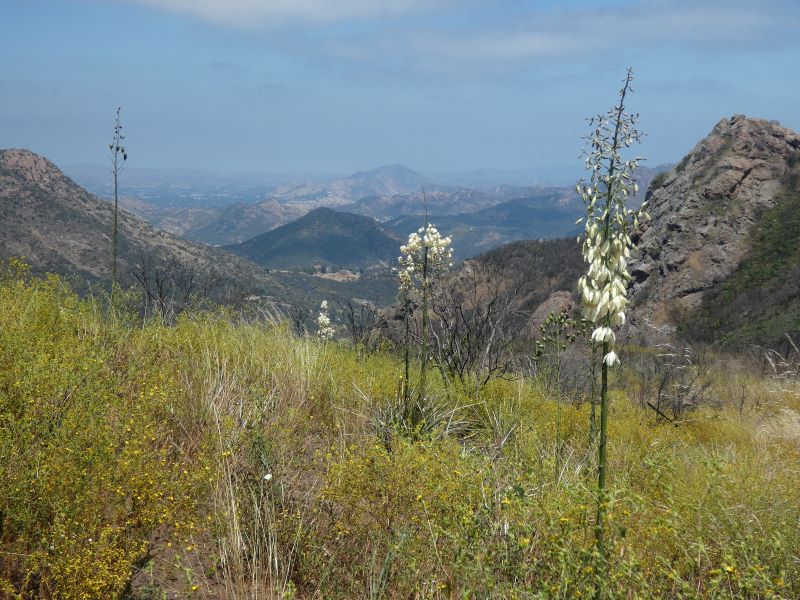
When it does flower, a single chaparral yucca plant can produce thousands of white, bell-shaped blossoms, each the size of a child’s hand. The inflorescence grows at an astonishing rate to a height of as much as 15 feet, fueled by moisture and nutrient reserves stored in a rhizome-like root that is protected by thick insulating layers of fiber. That root enables Chaparral yucca to begin regenerating almost immediately after a wildfire. New chaparral yucca leaves are often the first welcome touch of green in a post-wildfire hellscape, a living symbol of regeneration and rebirth. The Chaparral yucca has evolved for life in the wildfire zone—not only can it regrow from its root, but its seeds germinate more quickly after being exposed to flame and heat.
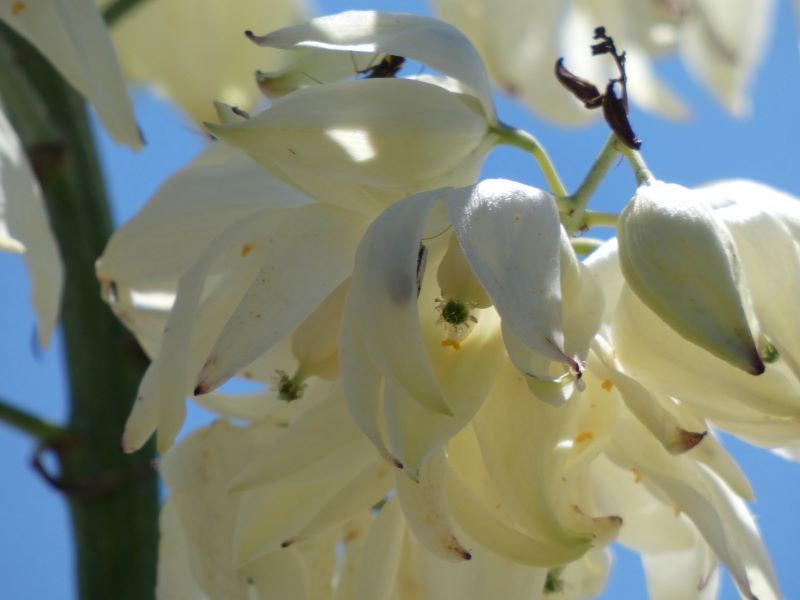
At night, these spectacular flowers produce a soft, sweet fragrance to attract a special pollinator, a tiny moth that lives in a remarkable symbiotic relationship with the plant: pollinating its flowers, and receiving in exchange a safe place to lay its eggs, and for for its larvae to grow to maturity.
Many pollinators are drawn to the chaparral yucca’s nectar, but only Tegeticula maculata, the California yucca month, can pollinate the flowers, and ensure that there will be a new generation of plants. This small, frail insect is responsible for the continued existence of one of the most robust and successful plants in the Chaparral ecosystem
Every spring, local naturalists and wildflower enthusiasts go slogging through mud and boulders and poison oak in the hope of seeing rare and beautiful Humboldt lilies, but chaparral yucca is just as spectacular, and often grows by the side of the road, within easy reach for a closer look. Both bloom in late spring and early summer, both have abundant flowers that tower over the observer. Both are California endemic species. Both are beautiful. The difference? Is it that one is rare with no guarantee one will find it, and the other so ubiquitous that we take it for granted as just part of the local landscape? This amazing wildflower deserves a closer look, and it’s almost always as close as the nearest trail or overlook.
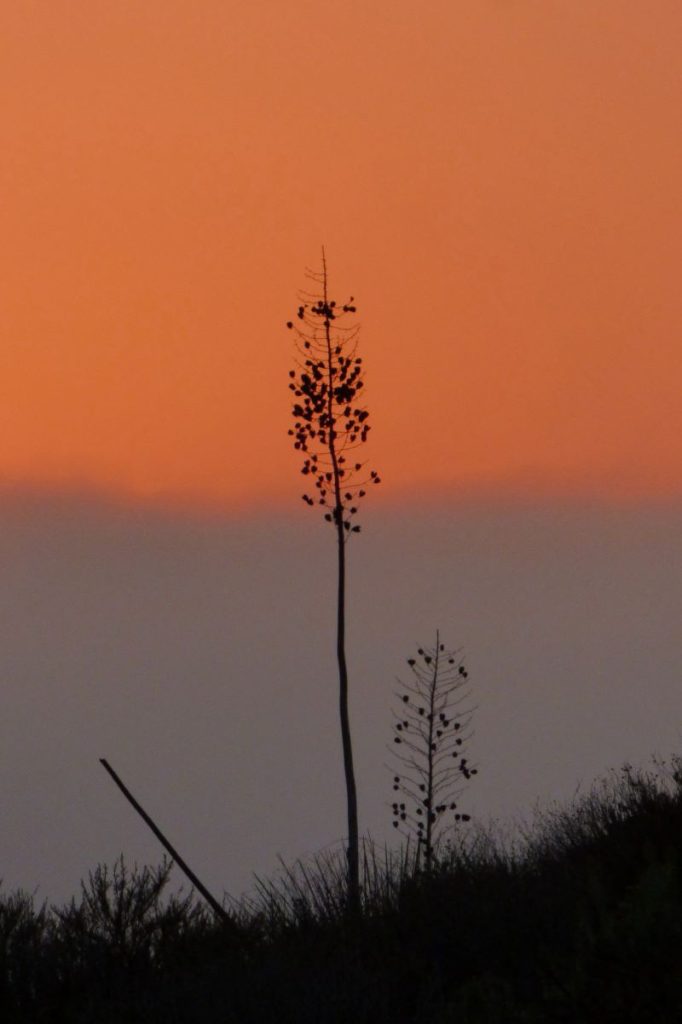
These myriad bells,
like muted voices from a distant hill,
whisper a call to worship…
‘Come where the anthem
is bird-sung,
where light and sun
can warm the body
as clouds lift the spirit;
Come where inmost thoughts
are prayers of faith in lupin blue.’
The candles of the Lord
burn white
upon their altar of the hills…
—Lorraine Ussher Babbitt, “Yucca Tapers,” This Fierce Infinity,1958




